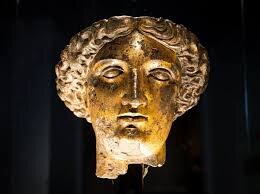Sosus of Pergamon: The Unswept Floor, Roman Mosaic, 2nd century CE
A Roman mosaic based on an earlier painting. It depicts the remnants of a dinner party scattered all over the floor of a dining room. Do you see the mouse?
Your Custom Text Here

Sosus of Pergamon: The Unswept Floor, Roman Mosaic, 2nd century CE
A Roman mosaic based on an earlier painting. It depicts the remnants of a dinner party scattered all over the floor of a dining room. Do you see the mouse?

Augustus of Primaporta, Early 1st century CE, reconstructed copy of marble, that is a copy of bronze, with paint.
Sometimes as we look at the art left behind by ancient civilizations we expect that they intended their sculpture to be viewed as the bleached white examples we see today however, that is not the case. The sculpture of the Greeks and the Romans was painted. We know this because remnants of the color survive and in rarer cases, sculpture with the paint still applied survives.

Medusa, c. 1598 by Caravaggio.
Medusa has always been a popular character in art. The combination of female and monster seems to have been so tantalizing that most ancient and Renaissance artists had to take their turn. This work is a depiction of a ceremonial shield where the Gorgon is used to frighten enemies; a usage common in ancient art.

Ara Pacis, Roman Temple built for Augustus, 30-9 BCE, Rome.
Built to honor Augustus' battles in Spain and Gaul, the Ara Pacis was built as a celebration to the power of the Roman Empire and "peace" their dominance brought to them. Over the years it was buried as the city grew and was finally excavated in the 20th century.




The Great Bath, the Ancient Roman Baths, 1st Century A.D., Bath, England.
Built as a combination of a traditional Roman bath and an homage to the water Goddess Sulis Minerva, elements of the ancient baths were uncovered in the 17th Century, but it was not fully excavated until the 19th century.
